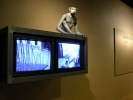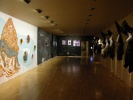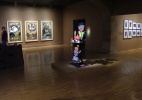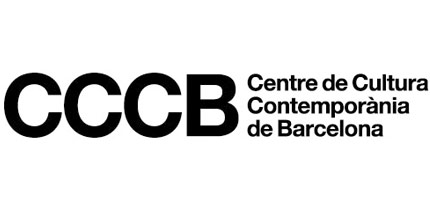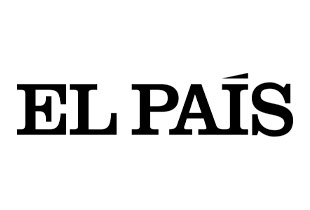Exhibition
Apartheid
The South African mirror
"Apartheid in South Africa can be seen, not only as an extreme manifestation of old, deeply-rooted Western racism, but also as a dramatic but clear precedent, metaphor and paradigm of some fundamentally inherent aspects of the current world order."
Pep Subirós
The CCCB presents "Apartheid. The South African Mirror", a conceptual and visual approach to the old and new forms of prejudice and racial discrimination, based on a wide selection of original artworks and documentary material.
The exhibition begins with a historical approximation to racism, and documents the development of the ideologies and practices that establish different categories of human beings -the races- in the same period, paradoxically, in which modern ideas are established with regard to dignity and equal rights for all individuals.
Following this, and as its central part, the exhibition shows in detail the social, political, economic, cultural and territorial system of apartheid in force in South Africa between 1948 and 1994. Apartheid as an extreme and transparent form of deeply-rooted Western racism.
Finally, the exhibition argues that over the last two decades new forms of racism and racial segregation have developed on a large scale, both within our democratic societies as well as, and especially, in the relationship between rich and poor nations.
To illustrate this historical narrative, "Apartheid. The South African Mirror" presents a wide selection of South African artworks from the nineteenth century to the present day, paying special attention to the period of Apartheid. As well as offering a panoramic view of the sensitivities and attitudes of the finest creators in relation to the themes addressed in the exhibition, it brings attention to how artistic creation has had and still has a major responsibility in and impact on the construction and consolidation of or the fight against prejudices and practices which, in the long term, dehumanize not only the victims, but especially, those who promote and are responsible for these attitudes.
Curators: Pep Subirós
Participants: Jane Alexander, William Kentridge
1. Racism and modernism
In this first section, previously unpublished material, illustrative of the different exhibitions of primitives which were held in Spain, and particularly in Barcelona, between 1897 and 1929, is presented. This was a genre of spectacle, real human zoos, common in Europe since the 1870s, which contributed decisively to the construction and popularization of the Eurocentric viewpoint and the legitimization of colonial policies.
The exhibition also shows how the application of racial theories and practices were not limited to the colonial world. In fact, some of the most extreme manifestations took place in countries considered to be politically or economically advanced, such as the United States and Nazi Germany. In both these cases, one of the principal and most harmful pseudoscientific movements related to the Darwinian theory of the evolution of the species -eugenics, a theoretical and practical discipline, the central aim of which was to maintain the purity of blood of the white race, as believed carrier of the most advanced forms of the human species-, played a large role.
2. The roots of apartheid
The peculiarity of the history of South Africa originated largely from the fact that the region was the simultaneous object of two different and often opposing colonial processes. The first colonizers were the Dutch, later called Boers or Afrikaners, whilst the second responded to British interests. Their diversity of interests and ideas caused a climate of continuous tension between the two white tribes, which finally ended up in open war.
On the battlefields, the confrontation was clearly resolved in favour of the British but, similar to what happened in the United States after the civil war, on the social, political, economic and cultural front, peace between the white tribes was achieved at the cost of the population defined as non-white.
When finally in 1910, the British and the Boers agreed on the creation of an independent and unified state, the South African Union, the great majority of the non-European population, as well as white women, lost the right to vote as well as almost all civil and political rights to which whites were entitled. A broad selection of old segregationist practices became law and official policies of the new state, upon which the fundamentals of the future apartheid were established.
As well as documentary material from the period, the exhibition presents a selection of artworks representative, on the one hand, of the European-inspired art practices followed by white artists and, on the other hand, the substantially different viewpoints expressed by black artists such as Gerard Sekoto, George Pemba and Ephrain Ngatane.
3. Total apartheid
The arrival to power in 1948 of the National Party, lead by David F. Malan, was the culmination of a campaign initiated in 1934 by the Afrikaner nationalists to impose their hegemony over the whole of South Africa.
The National Party's Apartheid programme, largely based on a racist reading of the Bible, promised to expel blacks from the cities and guarantee the privileges of Afrikaners as the self-proclaimed chosen people, in order to facilitate their access to jobs and to posts dominated by the British, by means of the reinforcement and generalization of discriminatory and repressive measures against different groups classified as non-whites.
As well as the biblical invocations, the National Party drew up and developed a relatively sophisticated ideological argument, already partially prepared previously and in part parallel to that used in the south of the United States, to justify apartheid and make it apparently compatible with the democratic principles of the European tradition to which it declared itself heir: this was the separate development policy.
According to this policy, it wasn't a question of considering some races to be superior or inferior to others, but to recognize the essential differences between them, not only in biological terms, but also and especially in cultural terms. Thus, values, attitudes and ancestral and traditional ways of life were differences which would make co-habitation impossible beyond that which was necessary for strictly economical needs.
The declared objective of apartheid was, therefore, with an apparent respect for democratic ideals and for a political system based on the force of the law, that each racial group was to live separately according to their own traditions, ruled by their own laws and governed by their own authorities, always, however, ultimately under the tutelage of the white authorities, as the incarnation and representation of a superior level of civilization.
In this section, the exhibition includes works rarely seen outside South Africa, by artists such as Albert Adams, Peter Clarke, Ernest Cole, Dumile Feni, David Goldblatt, Gavin Jantjes, Harold Rubin and Durant Sihlali.
4. States of emergency
The first resistance movements against Apartheid inspired by Gandhi's passive resistance tactics, took a peaceful form. However, repression was brutal, with incidents such as the Sharpeville massacre (1960), in which 69 demonstrators were killed by the police. The brutality of repression fuelled a more radical and harsher resistance movement, which would reach the point of no return with the students' revolt in Soweto in 1976.
The authorities tried to put out the fire by repeatedly declaring a state of emergency, with the aim of imposing order at any price, and giving the security forces carte blanche to act with impunity, outside the limits of the law.
In the middle of the 1970s, and especially due to the revolt initiated in Soweto and the assassination of Steve Biko, South African artistic creation experienced an extraordinary impulse, with the participation of artists of all colours and from all backgrounds.
Works such as those by Jane Alexander, Willy Bester, Norman Catherine, Keith Dietrich, William Kentridge, Ezrom Legae, Sfiso Ka Mkame, Billy Mandindi, Sam Nhlengethwa, Penny Siopis and Paul Stopforth, among other outstanding artists active in this period, clearly refer to their immediate context, and confront us with the material, political and moral hell of a society infected by the virus of racism and racial discrimination. At the same time many of them are works of exceptional quality and density that transcend this context and alert us to the abysses of cruelty and meanness into which the human spirit can fall in the defence of power and control, and especially to the proclivity of those who hold power to perpetuate, by whatever means are necessary, their privileges.
5. The difficult escape from the inferno of racism
The South African experience shows that it is possible to escape from hell, but that healing the wounds is a very long and difficult process.
In spite of the profound transformations carried out since 1994, many of the inequalities created by apartheid still remain, and resentment among racial groups is unfortunately still alive.
However, artistic creation in the post-apartheid South Africa continues to be infused with extraordinary vitality and richness.
A considerable part of this new creativity has a certain introspective nature, placing the emphasis on individual experience. However, concern for the collective difficulties, conflicts and hopes, for example in the area of historical memory, social justice, urban life and new forms of racism and discrimination, continues to be the prime focus of attention of many of the best artists who were active during apartheid as well as for younger artists, such as Conrad Botes, Churchill Madikida, Johannes Phokela, Nandipha Mntambo, Lolo Veleko and Donovan Ward.
A significant difference, however, is that if during the previous period many of the works were an anguished cry, in this new period they often tend more towards a tone of reflection, in some cases filled with humour and irony.
Like the country itself, South Africa's art continues to constitute a stage and a privileged observatory upon which and from which we can approach the cardinal issues of our world.
6. Global apartheid: the old South Africa as a paradigm
New and old forms of racial discrimination and segregation are reappearing, both in the current world system as well as inside formally democratic societies. Unfortunately, these do not consist of isolated episodes, but are elements symptomatic of the new international order, or local answers to maladjustments and problems which arise due to the globalization of the large economic and social movements dominated not only by the neo-imperial logic of the main powers and large economic corporations, but also
by notions of racial superiority which ignore the principle of basic equality of all human beings.
The exhibition closes with a selection of documentary material illustrative of the present day phenomena which, on an international level, clearly evoke apartheid and, in some cases, reproduce its essential traits: the treatment of the majority world by dominant countries, as if they were Bantustans; which is to say, as workforce reserves which must be kept in a state of chronic poverty and political and social isolation, and under political and military iron control.
A dramatic materialisation of this is found in the systems of tangible or intangible frontier walls and fences existing or in construction between the United States and Mexico, between Africa and Europe on both shores of the Mediterranean, and also in the Canary Islands, as well as - albeit with specific geo-political factors - between Israel and Palestine. These barriers and systems of control and surveillance are justified with arguments very similar to how the ideologists and promoters of apartheid combined a bare practice of white supremacism with a formally condescending and paternalistic rhetoric on the virtues of "separate development" between the different racial groups.
As well as this documentary material, the last section includes works by Peter McKenzie, Johannes Phokela, Bernie Searle, Donovan Ward and Zapiro.
Related contents
Jane Alexander: "Security with Traffic" (Influx Control)
"Apartheid. The South African mirror" Installation at the Pati de les Dones CCCB
Reportage on Jane Alexander’s installation in the Pati de les Dones at the CCCB on the occasion of the exhibition Apartheid. The South African Mirror. A triple fence, topped with concertina wire, evokes the barriers blocking entry to European Union territory in Melilla. Various ...
Negro towns, human zoos
Apartheid. The South African mirror
From the 1870s to the 30s of the 20th century, presentations of ethnic villages proliferated in all European capitals, authentic human zoos in which groups of indigenous people from colonized regions - particularly from Africa - were exhibited as a demonstration of both their physical, racial uniqueness, as of their primitive ways of life.

